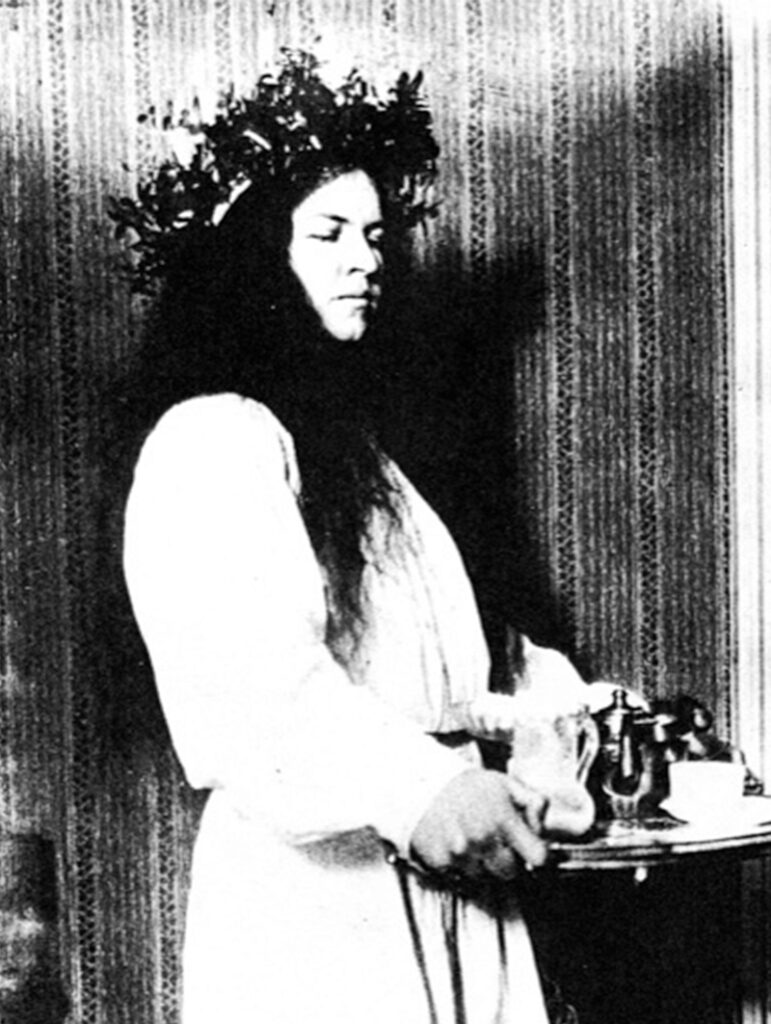
Christmas celebration with Lucia in the Jansson family

The Christmas celebrations in Tove Jansson’s childhood family were a mix of traditions from Finland and Sweden, with the most notable being that Tove’s mother Signe “Ham” Hammarsten Jansson used to wear a Lucia dress and wreath with candles on Christmas Eve morning.
In 1965, Tove Jansson was contacted by the Swedish magazine Tidningen Vi, which wanted her to write a text about Christmas recipes from her childhood. However, there was to be no text about what was served on the Christmas table in the Jansson family, but instead Jansson wrote the story “Vår magiska jul” (Our Magical Christmas) which begins with the words:
The smaller you are, the bigger Christmas is.
In the text, Jansson describes, from a child’s perspective, the mixture of Swedish and Finland Swedish Christmas celebrations in the Jansson home, “a mess”, according to Jansson. As an example, she states that her mother Signe “Ham” Hammarsten Jansson used to dress up as Lucia on Christmas Eve morning.
…all mothers sew presents at night. On Christmas Eve, they all become Lucias, with a great wreath with lots of candles in it on their heads.

 Illustration of a Lucia for a Christmas card made by Tove Jansson.
Illustration of a Lucia for a Christmas card made by Tove Jansson.History of the Lucia celebration
The Lucia tradition in the Nordic countries, mainly in Sweden and Swedish-speaking Finland, has a long and complex history that is a mixture of pagan and Christian traditions. In the Middle Ages, the Christmas pig was slaughtered on the night of Lucia on 13 December, which was celebrated with food and drink.
According to folklore, it was also on this night that all sorts of evil was out and about, including the devil Lucifer. Therefore, people were supposed to stay awake all night and make sure nothing surprising happened.
As with many Christian traditions, they then took a Christian element and placed the actual celebration on the pagan holiday people were used to celebrating, just as they placed the celebration of Christmas Eve and the birth of Jesus at the time that the pagan Nordic people had celebrated the Midwinter Blot during the darkest time of the year.
13 December was named after the Italian saint Lucia, who is the model for today’s modern Lucia celebration with a white-clad Lucia wearing a chandelier in her hair.
Lucia on Christmas Eve morning
Regardless of how the tradition originated, one thing that is common to all Lucia celebrations is that they take place on Lucia Day, 13 December. However, this was not the case in Tove Jansson’s childhood home, where Lucia was celebrated on Christmas Eve morning. This is how Tove herself writes in the short story Christmas in the autofictional short story collection The Sculptor’s Daughter from 1968:
“In Sweden people stuff their own sausages and make candles and carry small baskets to the poor for several months and all mothers sew presents at night. On Christmas Eve they all become Lucias, with a great wreath with lots of candles in it on their heads.
The first time Daddy saw a Lucia he was very scared, but when he realised it was only Mummy he began to laugh. Then he wanted her to be a Lucia every Christmas Eve because it was such fun.
I lay on my bunk and heard Lucia starting to climb the steps, and it wasn’t easy for her. The whole thing was as beautiful as being in heaven and she had modelled a pig in marzipan as they do in Sweden. Then she sang a little and climbed up the steps to Daddy’s bunk. Mummy only sings once a year because her vocal cords are crossed.”

 Tove Jansson’s mother Signe “Ham” Hammarsten Jansson wearing the Lucia wreath in her youth.
Tove Jansson’s mother Signe “Ham” Hammarsten Jansson wearing the Lucia wreath in her youth.That this tradition came from Ham’s childhood home in Sweden is clear, even if we don’t know the background to it among them. In an interview with Ham about combining family and professional life in the magazine Astra from 1922, the journalist Märta Schultz-Cajander writes as follows: “Signe Hammarsten Jansson has brought to her new home country the beautiful tradition of her childhood home, that on Christmas Eve morning, she dresses as Lucia, in white with a wreath of green and lights in her hair, and with a coffee tray full of yule delicacies, she wishes her family a Merry Christmas“.”
Read more about the Astra article.

 Tove Jansson’s illustration of one of Mymble’s daughters as Lucia for the magazine Nya Pressen in 1950.
Tove Jansson’s illustration of one of Mymble’s daughters as Lucia for the magazine Nya Pressen in 1950.Want to stay updated about the latest news and events – such as interesting exhibitions – around Tove Jansson? Sign up for the quarterly Tove Jansson newsletter!










